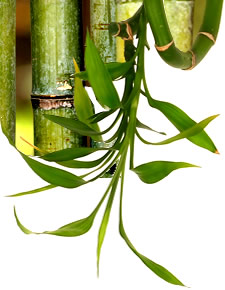

Bamboo Introduction |
| Bamboo is just grass, but it varies in height from dwarf, one foot (30 cm) plants to giant timber bamboos that can grow to over 100 feet (40 m). It grows in many different climates, from jungles to high on mountainsides. Bamboos are further classified by the types of roots they have. Some, called runners, spread exuberantly, and others are classified as clumpers, which slowly expand from the original planting. There are also varieties of root systems that are a mixture of these types. Generally, the tropical bamboos tend to be clumpers and the temperate bamboos tend to be runners.
Bamboo is both decorative and useful. In many parts of the world it is food, fodder, the primary construction material and is used for making great variety of useful objects from kitchen tools, to paper to dinnerware. The Species Source List contains a listing of the bamboos that are commonly used for furniture, construction, musical instruments and many more things. The species most-often identified with the giant panda is Gelidocalamus fangianus, but Fargesia spathacea, Sinarundinaria chungii, Sinarundinaria nitida, and Sinarundinaria fangiana are common bamboos in the panda's home range. There is a lot of confusion in the naming of bamboos. There are both common names, which vary from place to place, even within one country; and there are the botanical names, which vary less from place to place, but are still not well-standardized. For a explanation of why this is, Gib Cooper has written a short discussion of the taxonomy problem. |
© Copyright yayixm.com All rights reserved. Unauthorized duplication in part or whole strictly prohibited by international copyright law. |
|
|